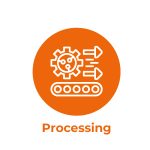Factory Processing
A model for estimating color increase in refined sugar during storage
Last Updated: junio 11, 2025The color of all types of sugar, including sugar from sugarcane and beet sugar, tends to increase during storage between production and shipment, and is influenced by sugar characteristics, storage conditions, and duration. This increase can be significant, impacting compliance with product specifications and the quantity of sugar available for sale
Application of antimicrobial agents at minimum inhibitory concentration values for optimal control of microbial isolates from Louisiana sugarcane factories
Last Updated: junio 11, 2025Gillian O Bruni and Evan Terrell USDA-ARS Southern Regional Research Center, 1100 Allen Toussaint Blvd, New Orleans, LA 70124, United States of...
Application of antimicrobial agents at minimum inhibitory concentration values for optimal control of microbial isolates from Louisiana sugarcane factories
Last Updated: junio 11, 2025Microbial isolates from sugar crop-processing facilities were tested for susceptibility to industrial antimicrobial agents to determine minimum inhibitory concentration (MIC) values for optimal dosing. Hydritreat 2216 (peracetic acid) showed broad spectrum activity against all bacterial isolates as well as Saccharomyces cerevisiae.
Applications of machine learning to estimate economic impacts of starch and dextran on sugar manufacturing
Last Updated: junio 11, 2025Polysaccharide contamination (e.g., starch, dextran) is among the leading causes of decreased sucrose yields from sugarcane processing. Although there is a wide body of literature on management and mitigation strategies, there is little quantification of the associated economic impact of polysaccharides relating to recoverable sucrose losses.
Coffee husk as an alternative biofuel for bagasse-fired boilers
Last Updated: junio 11, 2025This study was developed due to the need to find an alternative fuel to supply the growing demand for steam in new processes of the Ingenio Risaralda mill. Coffee husk is obtained from the farms in the region where coffee is processed and arrives at the mill in trucks in loads of 10 t and is unloaded into the feed hoppers.
DataCane by Cenicaña: optimization of efficiency and maintenance in sugarcane mills through Industry 4.0
Last Updated: junio 11, 2025To address the need to maintain and increase efficiency, as well as to make informed decisions in the sugarcane agro-industrial sector, which are essential for maintaining competitiveness and sustainability, Cenicaña developed DataCane.
Developments in wastewater treatment and reuse in the sugar industry: drivers, challenges and implications
Last Updated: junio 11, 2025Water is a finite and valuable resource with great significance for the sustainability of the sugar industry. Increasing water scarcity, stringent environmental regulations, and stakeholder awareness have put pressure on the industry to reduce its water usage and avoid contamination of existing water resources through the release of effluents.
Direct and indirect effects of climate change on sugar quality and storage stability: the case of the Brazilian 2024/25 season
Last Updated: junio 11, 2025In the 2024/2025 sugarcane season in Brazil faced extreme weather events, including droughts and heatwaves, which significantly impacted sugarcane yield and quality. While yield reductions due to climate variability are well-documented, their effects on sugar quality and storage remain underexplored.
Direct cane analysis: a comparison of the hydraulic press and wet disintegration methods
Last Updated: junio 11, 2025In Colombia’s sugarcane agroindustrial sector, there are two main methods for evaluating cane quality in terms of sucrose, Brix, fibre, and moisture; extraction by wet disintegration, recognized as the official method by the International Commission for Uniform Methods of Sugar Analysis (ICUMSA), and the hydraulic press extraction method, which ICUMSA granted a tentative status in 2022 and an Official (Reference) status in 2024
Efficient sugar production with simultaneous diversion of process intermediates for ethanol production
Last Updated: junio 11, 2025The Indian Sugar Industry has struggled for a long time but has realized that only diversification can lead to a sustainable sugar industry. It is important to create a sugar supply-demand balance, enrich the product portfolio through production of sugars of qualities required by different sectors, and utilize the by-products for production of green and renewable energy.
